Comprehensive Guide to Understanding and Making Use Of a Tachometer Effectively
Comprehensive Guide to Understanding and Making Use Of a Tachometer Effectively
Blog Article
The Value of a Tachometer in Monitoring Engine Rate and Performance in Automotive Applications
In the world of automotive engineering, the tachometer stands as a critical tool in the chauffeur's collection, offering a straight home window into the internal operations of a car's engine. Past its feature as a mere gauge of changes per minute (RPM), the tachometer functions as an important device for enthusiasts and experts alike, supplying real-time insights into engine efficiency and health. Understanding the value of this device goes beyond surface-level monitorings, delving into the elaborate relationship between engine rate, power result, and general driving experience. As we explore the complex role of the tachometer in automobile applications, a deeper admiration for its effect on car characteristics and efficiency begins to emerge.
Significance of Keeping An Eye On Engine RPM
Keeping an eye on engine RPM, or transformations per minute, is a vital element of auto maintenance and efficiency examination. Engine RPM straight correlates with the speed at which the engine's crankshaft revolves, showing how quickly the engine is running - tachometer. By monitoring RPM, technicians can analyze the health and wellness of the engine, find prospective issues, and fine-tune performance. An unusual RPM analysis might indicate problems such as engine misfires, damaged ignition system, or problems with the gas delivery system. Continually high RPM analyses could show aggressive driving habits or the requirement for a higher equipment shift to improve gas effectiveness.
Moreover, monitoring engine RPM is necessary for efficiency analysis in auto racing and high-performance cars. In recap, monitoring engine RPM is not only crucial for identifying issues however additionally for maximizing engine performance in various vehicle applications.

Advantages of Real-Time Data
In automobile applications, real-time data plays a vital duty in supplying instantaneous understandings into the performance and condition of the vehicle. By continually keeping track of different specifications such as engine speed, temperature, fuel consumption, and more, real-time data uses countless advantages that add to improved effectiveness and safety when driving.
One significant benefit of real-time information is its capability to alert chauffeurs and specialists to any abnormalities or concerns immediately. This aggressive strategy allows quick identification of possible issues, enabling timely interventions to avoid further damages or malfunctions. Furthermore, real-time data promotes efficiency optimization by offering instant comments on driving habits and engine performance. Motorists can adjust their actions in real-time based on this details to achieve better fuel economy and lengthen the look at this site lifespan of their lorry.

Additionally, real-time data plays an essential role in contemporary automobile diagnostics, allowing technicians to swiftly detect and deal with breakdowns. This brings about decreased downtime, reduced upkeep expenses, and eventually, boosted general car dependability and long life (tachometer). By taking advantage of the power of real-time data, automotive stakeholders can make informed choices that positively affect both the performance and long life of the lorry
Effect on Equipment Shifts
Reliable gear changes in automotive applications dramatically affect general efficiency and driving experience. The tachometer plays an essential function in enhancing equipment changes by supplying real-time engine speed information to the driver. When approaching the redline on the tachometer, it signals the chauffeur to upshift to stop over-revving the engine and causing prospective damage. On the other hand, downshifting at the best moment can assist preserve the engine in its power band, guaranteeing receptive velocity when required.
Additionally, the tachometer aids in accomplishing smoother equipment shifts, particularly in manual transmissions. By keeping track of engine speed, vehicle drivers can implement equipment shifts at the optimal RPM array, lowering jerking motions and minimizing wear on the transmission parts. This precision on duty adjustments not just enhances click driving convenience however likewise adds to fuel performance.
Enhancing Fuel Performance
Provided the important role the tachometer plays in maximizing gear shifts for efficiency and engine health, it straight adds to making best use of fuel efficiency in auto applications. By supplying real-time feedback on engine rate, the tachometer assists vehicle drivers in preserving one of the most effective RPM range for gas economy. When vehicle drivers regularly check the tachometer and adjust their driving routines as necessary, they can stay clear of unneeded fuel intake created by over-revving or carrying the engine.
Furthermore, the tachometer helps vehicle drivers determine the most fuel-efficient equipment to be in at any type of given moment, avoiding the engine from functioning more difficult than needed. This is especially essential throughout acceleration and cruising, where being in the best gear can significantly affect gas efficiency. In addition, the tachometer can alert drivers to possible mechanical issues that could be negatively impacting fuel economic climate, such as a slipping clutch or a stopped up air filter. In conclusion, the tachometer serves as a valuable device in improving fuel efficiency by promoting optimum driving habits and identifying areas for enhancement in the car's performance.

Optimizing Engine Longevity
The tachometer's function in keeping track of engine rate and efficiency is important in ensuring the longevity of automotive engines. Keeping track of the tachometer enables vehicle drivers to stay within the suggested RPM variety for their lorry, preventing unnecessary stress on the engine and expanding its lifespan.

Final Thought
To conclude, the tachometer plays a crucial duty in keeping an eye on engine speed and efficiency in automobile applications. By supplying real-time information on RPM, it enables for efficient equipment shifts, boosted gas performance, and maximized engine durability. This device is crucial for maintaining ideal engine efficiency and making certain the overall capability of an automobile.
Report this page